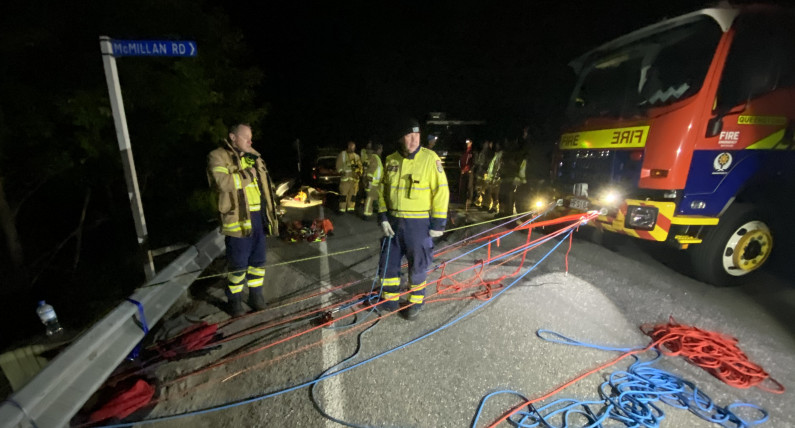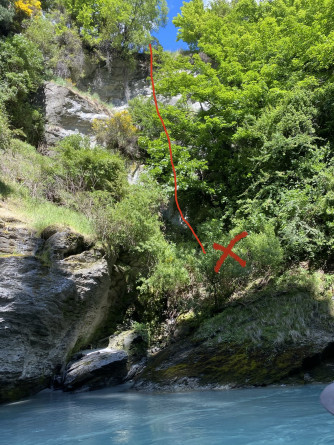
Specialist skill set makes all the difference in gorge rescue
Shortly after midnight on 22 November 2020, Police were notified that a young male had disappeared while walking above the Shotover River, east of Queenstown.
After arriving at the scene, Police interviewed his two companions and established that all three of them had been standing between the metal road barrier and the cliff before one of them slipped and fell into the gorge. His companions had tried to establish voice contact with him, with no response.
The weather at the time was marked by constant drizzle, with strong southerly winds and a temperature around five degrees. The Queenstown-based Otago Rescue Helicopter was tasked to complete a reconnaissance of the area and establish the man’s position in the gorge. They were able to complete a short aerial survey, without locating the man, before the high winds made it impossible for them to continue and they were stood down.
Within 30 minutes of the phone call to Police, Gorge Road was closed to oncoming traffic and the Queenstown and Arrowtown Fire and Emergency NZ (FENZ) units arrived on site. The Arrowtown unit included the specialist Line Rescue Team which covers the wider Wakatipu area.
Together with the Line Rescue team leader, Police quickly determined that the rescue was likely to be beyond the technical capacity of the Line Rescue Team. Wanaka-based Detective Alan Lee was brought in to assume command and to coordinate the overall response. While en route from Wanaka, Alan contacted the Queenstown Alpine Cliff Rescue team – part of the Wakatipu LandSAR group – to request assistance.
In the meantime, the Line Rescue Team worked to establish the man’s position in the gorge. St John paramedics arrived on site and set up a designated receiving area where the man could be stabilised and prepared for transfer to hospital. The two FENZ appliances were set up as anchors for several rescue lines.
At 1.30am – just over an hour from the initial phone call to Police – a member of the Line Rescue Team descended into the Shotover Gorge. Twenty metres below the road, they found a small ledge with a cap, gumboot and other personal items belonging to the man. They could also hear the missing man shouting for help, confirming that he was still alive and hadn’t fallen into the river.
A second Line Rescue Team member was then dispatched into the gorge, bypassing their colleague on the ledge. They were able to establish voice contact with the man but were not able to reach his location due to the nature of the terrain.
By 2am the Queenstown Alpine Cliff Rescue Team had arrived on site and shortly afterwards began their descent into the gorge. They located the man at the base of the cliff, another 20 metres past the ledge – a total fall of around 40 metres. He was seriously injured with head, shoulder, and back injuries.
Due to the vegetation and terrain surrounding the man’s landing spot, as well as his injuries, the rescue teams had considerable difficulty preparing him for extraction in a stretcher.
As the man was being prepped for extraction, the St John Ambulance team ran a practice session with FENZ and Police staff on how to transition the patient from the stretcher to the ambulance. This was necessary to ensure the transfer was as efficient as possible, without making the man’s injuries any worse.
Around 3.30am the extraction began, with the injured man being hauled vertically up the cliff face, accompanied by a member of the Alpine Cliff Rescue team. The terrain was steep to vertical with loose rock and vegetation.
“We had 12 FENZ crew providing the motive power on the rescue lines,” says Alan, “but the terrain was so difficult that it took over 40 minutes to haul the two of them 40 vertical metres.”
Shortly after 4am, the injured man arrived at the road, where he was stabilised and then moved into the waiting ambulance. Queenstown FENZ provided a crew member to drive the ambulance so the ambulance officers could focus on keeping their patient stable. The remaining rescue teams were extracted from the gorge a short time later, just as heavy rain set in.
“The area where the man was located was only a few metres above the Shotover River,” says Alan. “If he’d continued falling, or had attempted to self-rescue, he would have been at risk of falling into the river. With the extent of his injuries, he quite likely would have died.”

Given the technical nature of the rescue, and the number of agencies involved, elements of the Coordinated Incident Management System (CIMS) structure was used.
Each organisation was able to maximise the use of their assets and resources through having clearly defined responsibilities for control, logistics, operations, safety and welfare, Alan says.
“Whilst the operation was under the overall command of Police, actual control of the extraction was handled by the team leaders from the Alpine Cliff Rescue and Line Rescue teams.”
“This rescue simply wouldn’t have been possible without the individual actions – and collective response – of the highly skilled and experienced teams who came together that night.”
This article was first published in the December 2021 issue of Link magazine
